We have been evaluating general manager Doug Armstrong’s draft history with the St. Louis Blues, testing the claim that his career of successful drafting has made him a great GM. Here’s a catalogue of our other installments:
- 2010: Two stars arrive
- 2011: Second round success
- 2012: A diamond in the rough
- 2013: A year to forget
- 2014: Success after success
- 2015: Dunn and done
- 2016: A lot of promise
- 2017: Stanley Cup foundation
Armstrong had one of his worst draft years in 2012, and we’ll evaluate why, but even in an uncharacteristic off-year, he still brought in a diamond in the rough.
First Round
Jordan Schmaltz, D (Green Bay Gamblers, USHL), #25
The Blues had a tremendously successful 2011-2012 season, making the playoffs for the first time since 2008-2009, and winning the Central Division for the first time since the turn of the millennium. They made it to the second round and had their season ended by the red-hot Los Angeles Kings, who went on to win the Stanley Cup.
As a result, the team was picking low in the first round for the first time in many years (having traded their 2011 first-round pick), and with the 25th pick, they selected a right-handed offensive defenseman, Jordan Schmaltz.
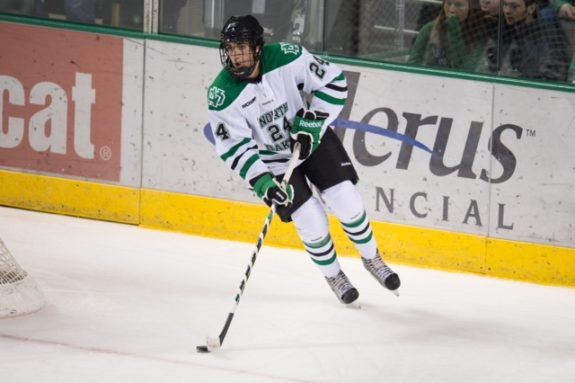
Schmaltz had collected 35 points in 46 games with the Green Bay Gamblers in his draft year and went on to score seven points in 12 games with a plus-10 rating in the playoffs. The Blues took a chance on raw talent here. Pierre McGuire described Schmaltz during the draft broadcast:
[Schmaltz] is another one of those picks that’s going to take time. St. Louis isn’t in any rush for this player to develop.
The Blues did give Schmaltz time to develop at the University of North Dakota, where he played alongside his brother, Nick. He wouldn’t debut for the club that drafted him until 2017.
Since then, Schmaltz has received inconsistent NHL playing time, and he hasn’t developed into the player the Blues had hoped for. The confidence he showed with the puck hasn’t made him a capable NHL quarterback, and his defense is too lackluster to compensate.
2018-19 was a make-or-break one for Schmaltz, and it became the latter. He played 20 games with the big club, collected just two points, and was sent back to the San Antonio Rampage of the American Hockey League.
Related: Revisiting Doug Armstrong’s Drafts – 2011
It’s looking more and more like Schmaltz will go down as the biggest bust of Armstrong’s St. Louis tenure as he’s the only Blues first-round pick under Armstrong that hasn’t developed into a quality NHL player.
Missed Opportunity: Brady Skjei, #28
The 2012 draft had a particularly weak first round which eases the pain of missing with Schmaltz. Still, if they’d wanted a first-round defenseman with a difficult-to-pronounce surname beginning with “S,” (admittedly, a set of very specific criteria), they could have done better with Brady Skjei.
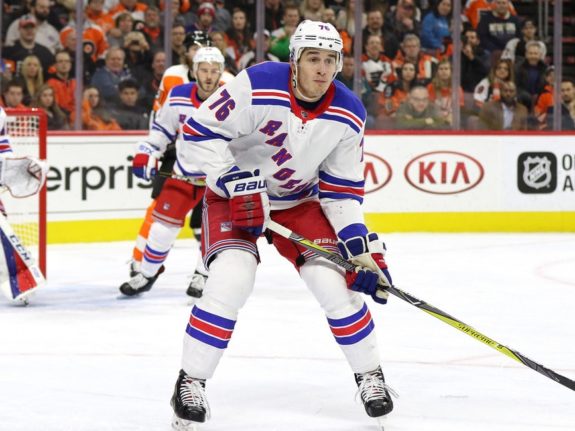
Skjei still has some things to prove in the NHL but he has had a much more successful career than Schmaltz. He was rewarded with a six-year contract extension and he’s a big part of the New York Rangers’ future. The same cannot be said about Schmaltz and the Blues.
Middle Rounds (2-4)
Samuel Kurker, RW (St. John’s Prep, USHS-MA), #56
The Blues’ second-round pick was Samuel Kurker, a winger out of high school in Massachusetts. He had 60 points in 24 games with his high school squad, and it was enough for the Blues to bring him in.
But that was the apex of Kurker’s career. He would go on to play in the NCAA (at Boston University and later Northeastern), with stops in the ECHL, the USHL, and the AHL. Save for one strong season with the Sioux City Musketeers, he has done nothing particularly noteworthy in that time. He never played a game in the NHL and is currently on loan to the Ontario Reign of the AHL.
Missed Opportunity: Devin Shore, #61
There were several decent NHL players selected shortly after Kurker in the second round, including Jordan Martinook and Damon Severson, but the best offensive player was Devin Shore, whom the Dallas Stars selected five picks later. Shore was later traded to the Anaheim Ducks and is a decent bottom-six contributor. It’s not a huge miss, but as Kurker never made the NHL, Shore would have been an improvement.
MacKenzie MacEachern, LW (Brother Rice High School, USHS-MI), #67
For a period, it seemed that MacKenzie MacEachern would be yet another player who had not made his NHL debut, but that changed on Jan. 10, 2019. The Blues were patient with the high schooler, whom they drafted in the third round in 2012, and it paid off.
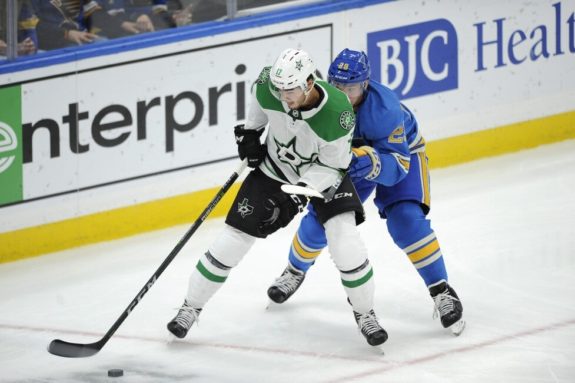
MacEachern has scored a goal and an assist in six NHL games and has added tenacity to the fourth line. He doesn’t have a very high ceiling, but it looks like he could be a decent contributor in the bottom-six, and there’s nothing wrong with that for a third-round pick.
Missed Opportunity: None
Generally, I won’t call a pick a missed opportunity unless it occurs within 10 selections of the player discussed. Shayne Gostisbehere was drafted at #78, 11 picks after MacEachern. Jimmy Vesey was chosen directly before the Blues’ choice, so he was unavailable.
The Blues were interested in Oskar Sundqvist at the time, who went to the Pittsburgh Penguins with the 81st pick. They eventually got their man anyway, and Sundqvist is now one of the most improved players in the organization, perhaps in the league.
Colton Parayko, D (Fort McMurray Oil Barons, AJHL), #86
Here is the true diamond in the rough of the draft, one of the best value picks the Blues have had in Armstrong’s tenure. Colton Parayko is now a fixture on the Blues’ defense, but he comes from humble beginnings. Playing in the Alberta Junior Hockey League, not one of the premier development leagues, the Blues did their best to “hide” Parayko from the competition.
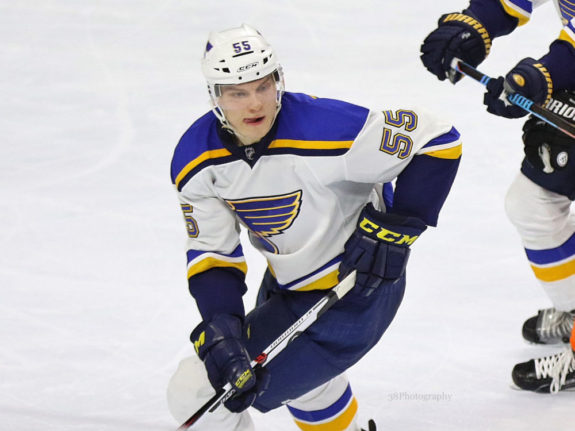
It worked, and the front office proudly selected Parayko late in the third round. He’s blossomed into a terrific NHL defenseman with a high ceiling and a huge shot. He’s on one of the more valuable contracts in the league and will be a huge part of St. Louis’ future. He’s the major acquisition in this draft that keeps it from being a total failure.
Missed Opportunity: None
Given the caliber of player that Parayko is, there’s no one that clearly surpasses him, but an interesting name was drafted immediately after him. The Anaheim Ducks drafted Frederik Andersen one pick later, and we recently ranked him third among starting NHL goaltenders. The Blues have no regrets about drafting Parayko, but Andersen is a phenomenal goalie, and it’s tough to imagine two better players going back-to-back late in the third round.
Nick Walters, D (Everett Silvertips, WHL), #116
Late in the fourth round, the Blues selected Nick Walters, a 6-foot-2, 200 pound defenseman from the Everett Silvertips in the Western Hockey League. Walters never made it particularly close to the NHL, only ever playing in four AHL games at the end of a season. He’s now in Germany’s second league, playing for the EC Kassel Huskies.
Missed Opportunity: Jaccob Slavin, #120
The Blues chose Walters at #116, and in the process missed out on a strong blueliner, Jaccob Slavin. Slavin has carved out a significant place with the Carolina Hurricanes, who are an underrated defensive team.
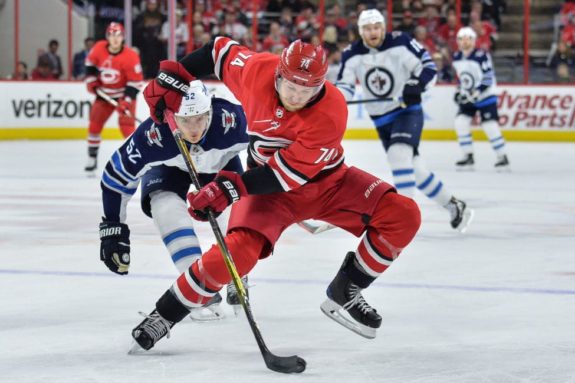
Slavin has averaged over 23 minutes a night this season, has 23 points in 50 games, and has logged close to 300 games in the NHL in his career. He also has a very impressive 55.7 Corsi For percentage in 2018-19. Compared to Walters, who never even sniffed the highest league, Slavin would have been a huge improvement.
Interestingly, if the Blues had chosen Skjei instead of Schmaltz and Slavin instead of Walters, they still would have had one left and one right-handed defenseman (in addition to Parayko) but would have had much better NHL success in the process.
Late Rounds (5-7)
François Tremblay, G (Val-d’Or Foreurs, QMJHL), #146
François Tremblay was a decent goaltender who played 57 games in the QMJHL in his draft season. That would end up being the highlight of his career, as he played fewer games in each of the next two seasons, and retired after the 2014-15 season.
Missed Opportunity: Alexander Kerfoot, #150
A number of passable NHL players were drafted shortly after Tremblay, but given that the Blues’ draft was already heavy on defense, the most logical missed choice would have been Alexander Kerfoot, who was chosen four picks later. Kerfoot is in his second season with the Colorado Avalanche, with whom he signed as a free agent after college. He has 69 points in 125 games and looks to be a decent second or third line center, an obvious improvement over a goalie who retired three years after being drafted.
Petteri Lindbohm, D (Jokerit U20, Jr. A SM-liiga), #176
Now we arrive at the fourth and final player the Blues drafted in 2012. Petteri Lindbohm was a tall, left-handed defenseman from Helsinki, Finland whom the Blues took after 41 games with the Jokerit U20 team.
Related: Revisiting Doug Armstrong’s Drafts – 2010
Lindbohm would arrive in the NHL fairly quickly for a sixth-round pick, logging 23 games in the 2014-15 season, and collecting two goals and an assist. All told, he would play in 40 NHL games across three seasons. He reached restricted free agency, after struggling with injury in 2017-18, and opted to sign in Switzerland, rather than taking his chances with the Blues.
Missed Opportunity: None
No one of particular note was drafted after Lindbohm (though there are a few recognizable names here and there). Forty games in the NHL isn’t bad at all for a late sixth-round pick, and Lindbohm might have seen more games in 2018-19, given the injuries the Blues have had to deal with and their lack of depth on defense.
Tyrel Seaman, C (Brandon Wheat Kings, WHL), #206
When you’re drafting late in the seventh round, you’re basically taking a shot in the dark, and under those circumstances, you might as well bet on a proven junior team like the Brandon Wheat Kings. The Blues did so by taking Brandon center Tyrel Seaman with the 206th pick in the draft.
Seaman collected 19 points in 32 games with the Wheat Kings in his draft year, playing nine additional games in the playoffs. Unfortunately, the next season, Seaman began struggling with concussion symptoms and decided to retire from the game rather than risk further injury.
Missed Opportunity: None
Sadly, we’ll never know whether Seaman had a future in the NHL, but none of the five players selected after him has a significant NHL resume, so the Blues did alright by picking him where they did.
Final Grade: C-/D+
The Blues took a chance with Schmaltz in the first round, a chance that looks like it will not pay off. Only four of the eight players the Blues drafted even saw the NHL, and for Schmaltz and Lindbohm, the days of making an impact with the Blues are mostly behind them.
MacEachern’s NHL career is just starting, but it doesn’t look to have a very high ceiling. What the Blues do take away from the 2012 draft is Parayko, a stalwart right-handed defenseman who could play on the top pairing for most teams. Because of this, Blues fans tend to have a little too high of an opinion on him, but there’s no doubt that he’s a strong NHL defender and a steal for a player taken late in the third round.
Still, it’s unacceptable to only come away with one impactful NHL player from eight picks in a draft. The 2012 Draft will not be a highlight of Doug Armstrong’s resumé.